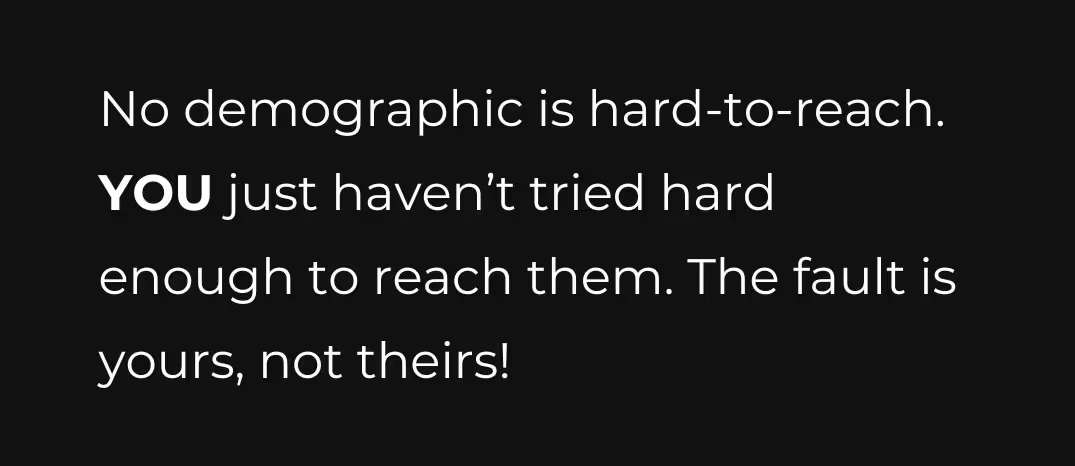Why ‘Hard To Reach’ Is The Wrong Term

Let's throw the term hard-to-reach in the bin!
Media, marketing and advertising have the power to influence and shape the world. When operated correctly, they should have outputs informed by frequently immersing into the hearts and minds of target audiences through insight.
The best way insight should be used and interpreted though, is not in averages. Not what the total universe from a survey thinks. Not what the headline PRable stat is. The best way to make data come to life is by celebrating its nuance — understanding differences amongst different ethnicities, age groups, genders, sexualities and interests.
In the UK, up until a few years ago, pollsters and agencies could claim that a study was 'Nat Rep' as long as it ticked census data percentages solely for age, geographical region and gender…how can we possibly unpack the nuance of data with this?
Time and time again agencies and brands claim they're guided by insight — told that the population thinks like this, prefers this advert and likes this influencer — only to put out the comms and receive backlash.
The problem lies in the lack of nuance in the people being sampled. It simply doesn't exist amongst the big research and insight agencies because for too long, the industry has operated with a race-to-the-bottom mentality: get me results from 10 trillion people tomorrow for £1 please!
Our jobs should be difficult because this isn't an easy game. Yet, we want to make it even easier to report on data that supposedly represents what people think.
For anybody who missed out on sipping rosé in Cannes or any industry conference that's taken place this year, here's the summary of the conversations… AI is the future.
A few years ago it was the metaverse and now AI is the tool that industry 'experts' bang on about. The scariest conversations are happening in the potential use of AI to support insight gathering of so-called 'hard-to-reach' audiences. The creation of synthetic (mock) data that can predict and scale up what individuals — who the industry has historically struggled to reach — think and feel.
Count me out of the synthetic data conversation. Until we can sort out the crap data quality that gets championed and proliferated — especially when it comes to minority groups — we will never be able to replicate the subtlety and idiosyncrasies of minority culture synthetically. Especially if you can't even do it properly.
If you genuinely want to reach and understand hard-to-reach audiences, it is going to cost you more — not at the fault of the audience but because of the industry's age-old problem with ignoring these groups. It shouldn't be a problem because inclusion should be seen as an investment that reaps financial benefit.
Want more unfiltered insights straight to your inbox? Subscribe to our newsletter for the latest trends, bold takes and tips on how to resonate with diverse audiences. Or, if you’ve got a project in mind, drop us a message—we’d love to chat!






